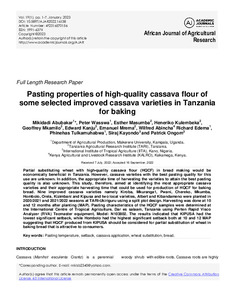| dc.contributor.author | Abubakar, M. |
| dc.contributor.author | Wasswa, P. |
| dc.contributor.author | Masumba, E. |
| dc.contributor.author | Kulembeka, H. |
| dc.contributor.author | Mkamilo, G. |
| dc.contributor.author | Kanju, E. |
| dc.contributor.author | Mrema, E. |
| dc.contributor.author | Abincha, W. |
| dc.contributor.author | Edema, R. |
| dc.contributor.author | Tukamuhabwa, P. |
| dc.contributor.author | Kayondo, S.I. |
| dc.contributor.author | Ongom, P. |
| dc.date.accessioned | 2023-11-01T14:42:36Z |
| dc.date.available | 2023-11-01T14:42:36Z |
| dc.date.issued | 2023-01-31 |
| dc.identifier.citation | Abubakar, M., Wasswa, P., Masumba, E., Kulembeka, H., Mkamilo, G., Kanju, E., ... & Ongom, P. (2023). Pasting properties of high-quality cassava flour of some selected improved cassava varieties in Tanzania for baking. African Journal of Agricultural Research, 19(1): 4F2316E70156, 1-7. |
| dc.identifier.issn | 1991-637X |
| dc.identifier.uri | https://hdl.handle.net/20.500.12478/8327 |
| dc.description.abstract | Partial substituting wheat with high-quality cassava flour (HQCF) in bread making would be economically beneficial in Tanzania. However, cassava varieties with the best pasting quality for this use are unknown. In addition, the appropriate time of harvesting the varieties to attain the best pasting quality is also unknown. This study, therefore, aimed at identifying the most appropriate cassava varieties and their appropriate harvesting time that could be used for production of HQCF for baking bread. Nine improved cassava varieties namely Kiroba, Mkuranga1, Pwani, Chereko, Mkumba, Hombolo, Orela, Kizimbani and Kipusa and two local varieties, Albert and Kibandameno were planted in 2020/2021 and 2021/2022 seasons at TARI-Ukiriguru using a split plot design. Harvesting was done at 10 and 12 months after planting (MAP). Pasting characteristics of the HQCF samples were determined at the International Centre of Tropical Agriculture, Dar es salaam, Tanzania using Perten Rapid Visco Analyzer (RVA) Tecmaster equipment, Model: N103802. The results indicated that KIPUSA had the lowest significant setback, while Hombolo had the highest significant setback both at 10 and 12 MAP suggesting that HQCF produced from KIPUSA should be considered for partial substitution of wheat in baking bread that is attractive to consumers. |
| dc.description.sponsorship | Cornell University |
| dc.format.extent | 1-7 |
| dc.language.iso | en |
| dc.subject | Cassava |
| dc.subject | Application |
| dc.subject | Wheat |
| dc.subject | Bread |
| dc.subject | Tanzania |
| dc.subject | Baking |
| dc.title | Pasting properties of high-quality cassava flour of some selected improved cassava varieties in Tanzania for baking |
| dc.type | Journal Article |
| cg.contributor.crp | Roots, Tubers and Bananas |
| cg.contributor.affiliation | Makerere University |
| cg.contributor.affiliation | Tanzania Agricultural Research Institute |
| cg.contributor.affiliation | International Institute of Tropical Agriculture |
| cg.contributor.affiliation | Kenya Agricultural and Livestock Research Organization |
| cg.coverage.region | Africa |
| cg.coverage.region | East Africa |
| cg.coverage.country | Tanzania |
| cg.coverage.hub | Eastern Africa Hub |
| cg.researchtheme | Biotech and Plant Breeding |
| cg.identifier.bibtexciteid | ABUBAKAR:2023 |
| cg.authorship.types | CGIAR and developing country institute |
| cg.iitasubject | Agronomy |
| cg.iitasubject | Cassava |
| cg.iitasubject | Food Security |
| cg.iitasubject | Plant Production |
| cg.iitasubject | Post-Harvesting Technology |
| cg.iitasubject | Value Chains |
| cg.journal | African Journal of Agricultural Research |
| cg.notes | Open Access Article |
| cg.accessibilitystatus | Open Access |
| cg.reviewstatus | Peer Review |
| cg.usagerightslicense | Creative Commons Attribution 4.0 (CC BY 0.0) |
| cg.targetaudience | Scientists |
| cg.identifier.doi | https://doi.org/10.5897/AJAR2022.16138 |
| cg.iitaauthor.identifier | Edward Kanju: 0000-0002-0413-1302 |
| cg.iitaauthor.identifier | Kayondo Siraj Ismail: 0000-0002-3212-5727 |
| cg.iitaauthor.identifier | Patrick Ongom: 0000-0002-5303-3602 |
| cg.futureupdate.required | No |
| cg.identifier.issue | 1: 4F2316E70156 |
| cg.identifier.volume | 19 |

